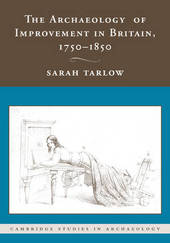
|
The Archaeology of Improvement in Britain, 1750-1850
Paperback / softback
Main Details
| Title |
The Archaeology of Improvement in Britain, 1750-1850
|
| Authors and Contributors |
By (author) Sarah Tarlow
|
| Series | Cambridge Studies in Archaeology |
|---|
| Physical Properties |
| Format:Paperback / softback | | Pages:238 | | Dimensions(mm): Height 254,Width 178 |
|
| Category/Genre | Historical geography
Archaeology by period and region |
|---|
| ISBN/Barcode |
9781107407299
|
| Classifications | Dewey:363.69094109033 |
|---|
| Audience | | Professional & Vocational | | Tertiary Education (US: College) | |
|---|
|
Publishing Details |
| Publisher |
Cambridge University Press
|
| Imprint |
Cambridge University Press
|
| Publication Date |
13 September 2012 |
| Publication Country |
United Kingdom
|
Description
In this innovative 2007 study, Sarah Tarlow shows how the archaeology of this period manifests a widespread and cross-cutting ethic of improvement. Theoretically informed and drawn from primary and secondary sources in a range of disciplines, the author considers agriculture and the rural environment, towns, and buildings such as working-class housing and institutions of reform. From bleach baths to window glass, rubbish pits to tea wares, the material culture of the period reflects a particular set of values and aspirations. Tarlow examines the philosophical and historical background to the notion of improvement and demonstrates how this concept is a useful lens through which to examine the material culture of later historical Britain.
ReviewsReview of the hardback: '[Tarlow] produces an extremely useful synthesis of much archaeological and historical research, demonstrating that people in this period made many significant changes to their material world which they described as 'improvement'. ... Tarlow has many useful and original things to say about the archaeology of the eighteenth and nineteenth centuries. ... this book is well worth reading, and also extremely easy to read - Tarlow writes with clarity and, at times, elegance. ... this is a stimulating and provocative read.' Landscape History
|